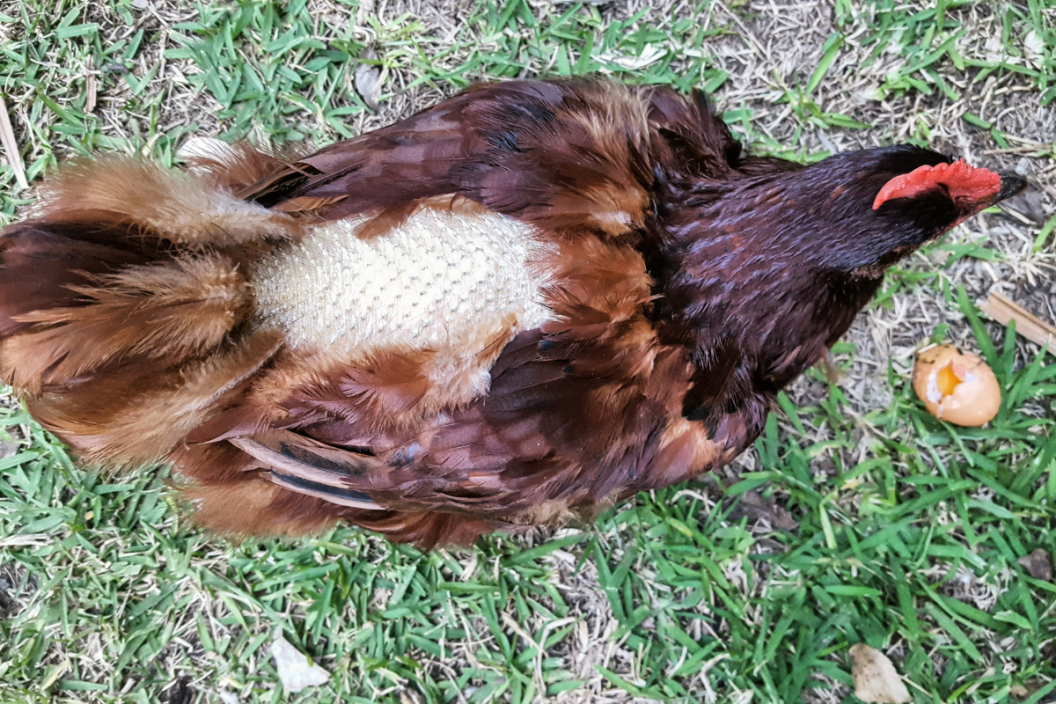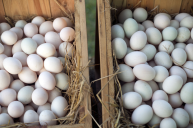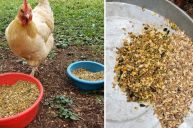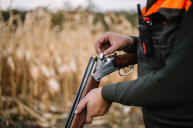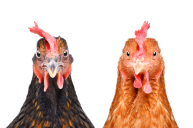Does your chicken coop a fierce pillow fight crime scene? Do you feel like your backyard flock is missing something?
It can be an alarming sight for new chicken owners if your chicken coop is filled with loose feathers, and you see bare spots or raggedy-looking feathers or porcupine-like pinfeathers on your chickens. However, they are probably going through a feather molt. Molting can create a mess and result in reduced egg production in laying hens. But when molting occurs, it's an indication that your new chickens are healthy and their bodies are doing exactly what they should.
As chicken keepers, you may wonder why chickens molt, how it affects their laying cycle, and when exactly is the molting season. Here are the answers to all of your molting questions, including how you can support your chickens.
Reasons Why Chickens Molt
The structure of the outer feathers forms a water-resistant and windproof barrier. In addition, tiny barbs and barbules grow off the feather shaft lock together (somewhat like velcro) on each outer feather.
Underneath these protective outer feathers are the downy feathers. The downy feathers have flexible barbs and barbules that give this type of feather "fluff" and provide your chicken insulation from heat and cold.
Over time, these protective or insulating old feathers wear and need to be replaced with new ones through the molting process. Molting (once complete) gives your chickens a full protective suit of fresh and glossy outer feathers and new downy under-feathers to protect them from all sorts of weather.
1. Annual Molts
Patrick Biggs, Ph.D. and nutritionist at Purina, explains that late summer and early autumn trigger annual molt due to shorter days. Each day after the summer solstice in late June is progressively shorter until the winter equinox on December 20, when the days once again begin to lengthen. The reduced daylight hours associated with late summer and fall days signals that it is time to begin replacing worn-out feathers.
The molting process is most typical in late summer or fall so that once the molt is complete, your chickens are prepared for winter weather with a complete set of new feathers to keep them protected from water, wind, and cold temperatures. Molting can happen, though, at any time of year.
2. Stress Molts
Chickens will also molt throughout the year if triggered by stress. Chickens can get stressed for many reasons, such as:
- Adding new chickens
- Experience a move
- Illness
- Food or water shortages
- Severe weather
- After brooding
Hens emerging from a broody period (whether or not they raised chicks) have been sitting on a nest with reduced feed and water for an extended time. Broody hens often molt once they stop being broody. This molt can extend their break in laying for several more weeks.
Also, adding new chickens to your coop can cause molding since it changes the pecking order. That kind of change can be very stressful for the existing chickens cause them to lose their feathers.
3. Juvenile Molt and First Adult Molt:
Adult chickens first fully molt at approximately 18 months of age. Before that, juvenile chickens have already gone through several mini molts. A chicken's very first molt sheds their chick fluff and gains genuine feathers, and they have several additional small molts as they grow in a complete set of true feathers, up until about five months or so of age.
Molting is a natural process, typically once a year for mature chickens.
How Long Is The Chicken Molting Process?
RELATED: 4 Chickens That Lay Blue Eggs, Because White Ones Are Boring
Generally, chickens take two to three months (8-12 weeks) to complete a molt, but it can take more or less time (up to 18-20 weeks or four to five months). The length of time depends on whether the chicken undergoes a "hard molt" or a "soft molt."
A "hard molt" is where the chicken loses most of its feathers in a short time. The molt will start at the chicken's head and neck before moving to their backs. Finally, the molt will hit their tail feathers. Some chickens start their molt early—these are the chickens that gradually lose feathers over time (a "soft molt") and can take up to four or five months to complete the molting process.
According to Tractor Supply, you should keep in mind that you will see a reduction in the number of eggs chickens lay during molt. Have patience. Laying resumes when less energy and resources are needed for growing feathers.
In fact, commercial layer operations that value egg production over all else will actually induce or force molts by withholding food so that all birds molt at once. The decline in egg production then becomes more predictable.
Obviously, we don't recommend anything like that for your backyard chickens. It is better to let their molting process move along naturally, and egg-laying will resume all in good time.
Note: a chicken losing feathers ONLY around the vent area likely has a mite or parasite problem; check that out more closely and don't assume it is a molt.
Best Care Tips for Molting Chickens
https://www.instagram.com/p/CShSMuAFxHv/
1. Increase protein in feed to support feather growth
Backyard chicken owners can best care for molting chickens by temporarily increasing protein intake. Increase the protein content of the chicken feed, add extra protein treats, and be patient during the molting process. Their food should increase to around 20 percent protein.
Nutrena recommends you support your molting chickens by feeding a high-protein feed. Growing new feathers requires a feed high in protein because the feathers themselves are mostly protein. You can buy a special feed ration for feather growth or use a high protein mix formulated for younger chickens or game bird feed WITH added calcium sources available (for example, crushed oyster shells) since feed mixes for younger chickens do not have the calcium in layer feeds.
2.Supplement with high protein treats.
Protein can be found in free-range bugs, black oil sunflower seeds, mealworms, scrambled eggs, grubs, and dairy products like yogurt. In addition, some backyard chicken owners supplement with cat food due to the protein content.
Cat food makes me a little uneasy, so I'm not likely to try it any time soon. Instead, Fresh Eggs Daily recommends molt meatloaf, which combines meat, eggs, and oats. Tuna is also another great option.
3. Try not to add additional sources of stress
This is not the time to be adding new flock members or moving. Stress will prolong the molting process, and your flock will not lay eggs anytime soon.
4. Be aware that pinfeathers are sensitive
Pinfeathers are the porcupine-like quills of new feather growth. Again, pinfeathers are sensitive, so avoid any chicken sweaters or rooster collars during a molt.
5. Separate any chicken that is getting pecked.
Exposed skin during a molt can be a target for other chickens. So know, if you see missing and loose feathers, your chickens aren't having a fierce pillow fight. They aren't going bald. They aren't going to look ratty forever.
Your chickens are growing a new set of protective and insulating feathers. Before you know it, they will have a complete set of new glossy feathers!
What's the funniest molting chicken you've ever seen? Let us know or show us on our Wide Open Pets Facebook page.
